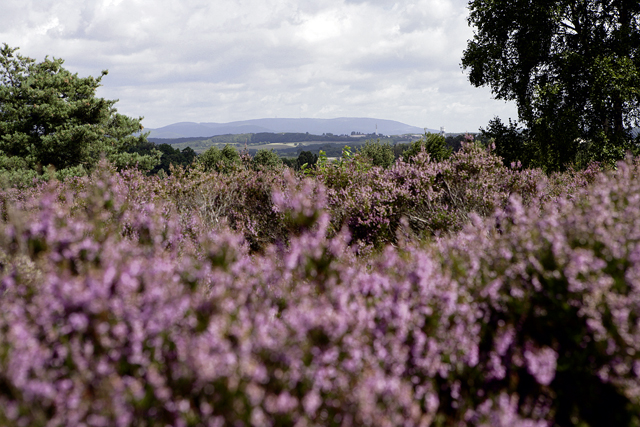
Many members of the Kaiserslautern Military Community have found temporary or even permanent homes in one of the many villages or towns surrounding Kaiserslautern and in the heart of the Palatinate Forest.
Talk of the Town is a series highlighting the union communities within the County of Kaiserslautern, the City of Kaiserslautern and the Union Community of Winnweiler in neighboring Donnersberg County. The series aims to inform American service members and their families about the communities they’re joining during their time in the KMC. A Union Community is an administrative territorial community composed of a group of individual towns or villages. Each month we will feature a different community and provide facts about its history, heritage, and the local experiences it offers.
The next stop in our series about our home away from home, leads us to the Union Community of Enkenbach-Alsenborn and Hochspeyer, situated on the northern tip of the Palatinate Forest and also borders Donnersberg County.
Originally Enkenbach-Alsenborn, consisted of the towns of Enkenbach, Alsenborn, Mehlingen, Baalborn, Neuhemsbach and Sembach and was a separate union community. In July 2014 it was combined with the community of Hochspeyer, consisting of the towns of Hochspeyer, Fischbach, Frankenstein and Waldleiningen.
Today the union community has 19,700 inhabitants and about 400 American families live throughout the community.
Andreas Alter, Mayor of the Union Community has been in office since July 2014 and would like to extend a warm welcome (see below).
Stone age, iron works and glass recycling
Findings from the neo-stone age and mounds from the Iron Age suggest that the area was populated in pre-historic times. Varying traces along an old transit road indicate that there were different settlements here throughout early history. Alsenborn was first officially mentioned in chronicles in the year 872 close to the source of the Alsenz stream. A monastery was founded in the nearby village of Enkenbach, meaning “stream of the enkens,” which means herdsmen, in 1148. Construction of the Klosterkirche, a monastery church, began in the year 1225 and was completed in about 1272. The sandstone church remains to be the most prominent landmark to date.
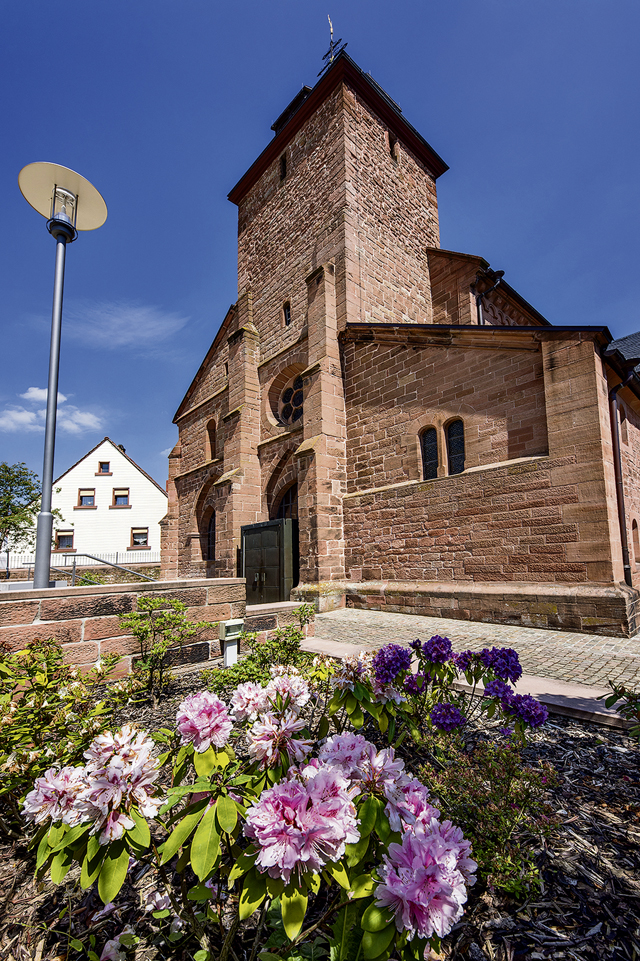
As a favorable traffic network to Kaiserslautern and connection to the railroad system, Enkenbach flourished in the iron and metal industry as well as trade, which led to an increase in population in 1871. In 1969 both villages were combined under the name Enkenbach-Alsenborn.
From 1953 to 1995 the community was also partially home to Sembach Air Base, the 86th Fighter Wing and 17th Air Force. In the meantime, the area has been developed into a commercial center with quick access to A63 and various enterprises, such as Becker, the largest waste disposal company in the region, a glass recycling firm, a storage area for heavy Army vehicles and also a K-9 Hotel for dogs.
Perfume, circus and the center of the world
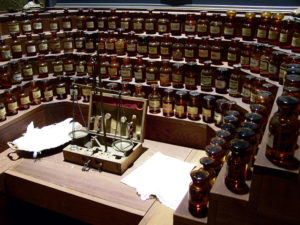
(perfume museum)
The Parfuemmuseum in Baalborn offers a glimpse of the art of creating perfumes and was designed based on the famous book “The Perfume.” It leads its visitors into a cellar decorated with flacons with tender rose and lavender scents, a distillery and ingredients for a multitude of fragrances in a 17th century setting.
The Bajasseum, a tiny museum resembling a circus tent centers on the theme and is located in Alsenborn. The town is commonly referred to as the “home of rope dancers” or “Bajasse” based on many people who made livings as musicians, marionette players, acrobats or animal tamers, and roamed the countryside as circus folk during the summers in the late 19th century.
The Weltachse (world axis), or center point of earth can be found between Johanniskreuz and Waldleiningen deep in the forest. At least this is what Paul Münch, a local poet, proclaimed it as and the stone to mark this fact was inaugurated in 1964. Every year it is “smeared and protected” in a solemn ceremony in an effort to save the planet.
There are a number of natural fountains within the community and both the Billesweiher and Schwarzweiher lakes are perfect venues for leisurely strolls in the forest. Castle ruins in Diemerstein and Frankenstein from the 12th and 13th centuries speak of medieval times and a chapel with a mighty belltower in Neuhemsbach that can be seen from afar marks the remains of a former castle.
Klosterkirche St. Norbert is the keenest landmark in the union community. The sandstone church in its late Gothic style is a unique mixture of ornamental Roman and Gothic elements. The former monastery garden was transformed into a relaxing herb and flower garden, with a fountain and an adjacent playground along “Wäschbach” (washing stream) used for laundry in former times.
From maneuvers to fields of heather
Until 1912 the area around Mehlingen was completely covered with forest. The Army administration in Kaiserslautern was then granted a drill ground at Kleiner Fröhnerhof and in 1938 first maneuvers took place at Grosser Fröhnerhof. Exercise operations with constant soil damage then fostered the emergence of heather. As of 1945 the area was used by French Forces, along with a part utilized by U.S. Armed Forces stationed at Ramstein and Sembach Air Bases. In 1994 it was decommissioned and returned to the government. The total area is 410 hectares and 150 hectares are comprised of heather, making it one of the largest heather landscapes in southern Germany. Numerous trails with educational stops along the way invite you to leisure strolls. Band wagon trips are offered in the summer and at point “Höhe 325°” you have a panoramic view over the country side with Donnersberg in the distance. Since 2001 it has been a nature preserve area named “Naturschutzgebiet Mehlinger Heide.”
Leisure, soccer and the police
Other leisure activities include bike and hiking trails, soccer-golf in Sembach, geocaching and K1 Rope Park recently re-opend. An array of clubs and associations offer sports, fishing, martial arts, tennis, basketball, bowling and even breeding pigeons.
Tor, Tor, Tor!!! – was the victory cry at the 1954 FIFA World Cup championship in Switzerland. Alsenborn is proud of its famous soccer players Fritz and Ottmar Walter, both born and raised in the town. Fritz was team captain and Ottmar player when Germany won the world championship.
Beware, the police is there. The Bereitschaftspolizei Rheinland-Pfalz is a training and specialization center for the police forces in the state. Teams from the center also assist in large-scale operations throughout the Federal Republic, such as demonstrations and protests, rescue missions or to provide for safety during 1. Fussballclub Kaiserslautern soccer matches.
Summer sun and festival fun
Both Alsenborn and Hochspeyer offer splash baths with slides and grassy sunbathing areas, while the pool in Mehlingen has a separate baby pool and a beach volleyball court. Colorful festivals take place throughout the summer months in every town. The “Kuckucks Kerwe” in Enkenbach in July and this year Alsenborn is celebrating its 1150th anniversary with a festival on June 25 and 26, with a parade on Sunday. Don’t miss out on festivities!
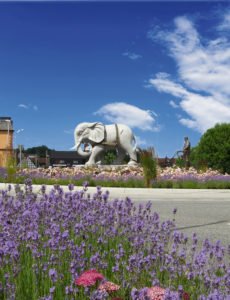
Did you know that…..
Former Sembach Air Base was located in two counties? The flightline section in Kaiserslautern County and the admin/housing area (Heuberg) about a mile further north in the Union Community of Winnweiler in Donnersberg County.
Circus people helped farmers plow their fields with elephants! There is a large granite elephant pulling a plow to commemorate the time at the traffic circle entering Alsenborn.
One of the largest solar parks in Germany is located in the former flightline area.
The inhabitants of the individual towns refer to each other with silly nicknames? The “Hohlwambe” (empty bellies) in Mehlingen, the “Kuckucks” (cuckoos) in Enkenbach, the “Bajazze” (rope dancers) in Alsenborn, the “Ochsen” (oxen) in Baalborn, the “Windmacher” (wind makers) in Neuhemsbach and the “Wind” in Sembach.
Heartfelt Welcome!
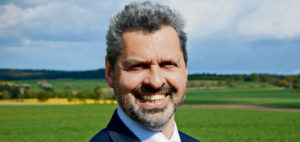
Hospitality is a high asset in any culture and the Union Community and its citizens would like to convey this value in a very special way. For decades American friends and partners have worked and lived together as neighbors and friends. Critical topics have been addressed and rectified in mutual agreement. We are pleased about your presence and are happy to have made your acquaintance. I am convinced that both sides profit from each other in many diverse ways! Personally, Americans are very close to my heart, as I often had the opportunity to meet your kinfolks and experience your culture during my visits to the USA. My son was able to experience your hospitality during his pilot training and later while he was stationed there. In the same way that my family and I were able to discover your country and people a bit, I would like to invite you to go on excursions in our union community. Our eight towns offer diverse options to visit attractive sites and enjoy our restaurants. You can actively participate in sports and music clubs. Many lifelong friendships have been made here, and we look forward to strengthening and deepening our friendships for a long time to come. Let us pray that the war in Eastern Europe and “at our front door” will soon be history! With the proverb “Unity is strength”, I cordially welcome you!







